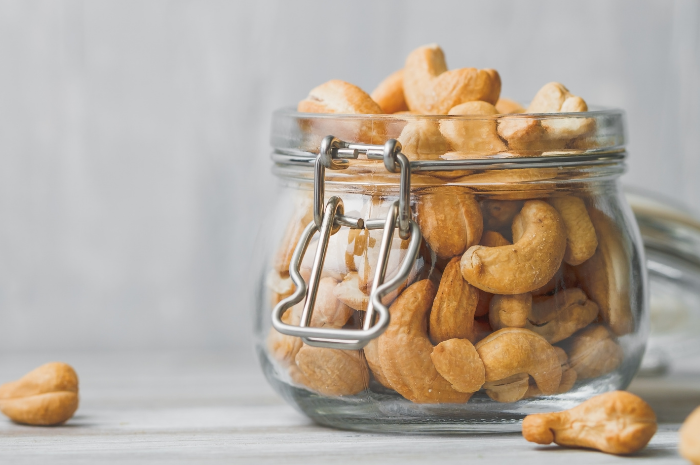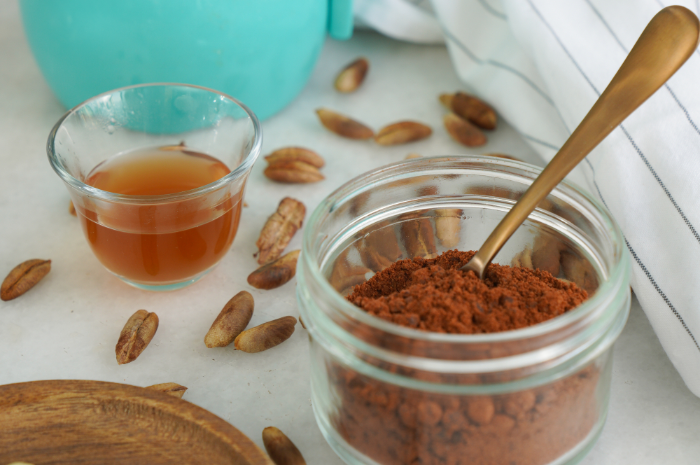Download your FREE ebook!

I can’t imagine a vegan or dairy-free person living without the humble cashew nut. It is the easiest to use and tastiest dairy-alternative in my opinion. From simple cashew milk to a more advanced cultured cashew-based cheese, there are so many ways to incorporate cashews and help you transition to a dairy-free diet, or even just reduce your dairy intake and change things up…which is what I do.
Furthermore, let’s not forget all the health benefits of this delicious nut. They are packed with soluble fiber and rich in vitamins, minerals and health-promoting phytochemicals that can help prevent disease. And since it’s high in heart-healthy monounsaturated fatty acids, eating cashews can help lower harmful LDL cholesterol while increasing good HDL cholesterol. In addition, if you take it a step further and culture your cashews to make cashew cheese (more on that below), then all that good bacteria will do wonders for your gut.
Word of caution, however, like anything else in life, too much of a good thing can be bad. Cashews are high in calories with around 200 per quarter cup, and consuming a large amount may cause an imbalance in your omega 3 to 6 ratio. It is also susceptible to mold, and so are other nuts. Keep that in mind especially if you don’t feel your best after consuming cashews regularly. Also, stick to raw cashews, and avoid store-bought roasted nuts as no one really knows what has been added to them. If you would like them toasted, roasted, sweetened or spiced…make it yourself at home. Try this addictive recipe…amazing as a snack or sprinkled over an Asian style salad or stir-fry.
Here are different ways to use cashews as a dairy-free alternative with ideas and inspiration mixed in.
Cashew Milk
Starting with milk as it’s so simple and easy. Unlike almond milk where you need to soak the nuts for 8 hours minimum and strain out the pulp, cashews only need a quick soak in hot water (or 3 hours in room temperature water), no straining, and it comes out super creamy. You also don’t need a high-speed blender to get a good result.

All you need is 1 cup cashews and 4 cups water which will give you 5 cups of cashew milk. Basically it’s a 1:4 ratio of cashews to water, so you can increase and reduce the cashew amount as you see fit. Once blended and creamy add in any flavoring or sweetener you like such as vanilla, honey, cinnamon or agave. Or just keep it plain. Use it in your smoothies, oatmeal, with cereal or in your tea and coffee. It’s also delicious if you freeze it and blend it with some coffee for a homemade frappe.
Cashew Cream
This is where the use of cashews really shines in a dairy-free diet and where your imagination can run wild. You will be doing the same as we did with the milk, soaking and blending, however, the liquid used will be much less, and the choice of liquid will be determined based on the result you want to achieve, be it sweet, savory or sour.

This cream can be used to make a variety of recipes such as:
-
As a base for an oil-free or mayo-free salad dressing by adding an acid of choice (lemon juice, vinegar), salt, pepper, garlic, onion and other flavorings using fresh or dried herbs.
-
To make cashew sour cream and using it with your favorite Mexican dishes. Just make the cashew cream above, reducing the water to 1/2 a cup and adding 1 tablespoon lemon juice, 1 1/2 tablespoons apple cider vinegar and salt to taste. Reduce or increase the water to achieve the desired consistency.
-
Use it to replace cream in pasta dishes. You can enjoy your favorite Pink Pasta now without any dairy.
-
Make a dairy-free Cucumber Yoghurt (Khiyar Bilaban) to serve with kibbeh, dolma or mujadarra. Make the cashew cream, and add lemon juice, finely chopped cucumber, minced garlic, minced fresh mint, and salt and pepper to taste.

That was just the savory applications…how about some sweet ones!
-
Sweeten the cashew cream with your choice of sweetener, adding some vanilla for flavor and use as a topping for pancakes, oatmeal or fruit crumbles.
-
Reduce and replace the water with coconut milk for a thick and luscious pudding, either vanilla or chocolate or dairy-free ice cream.
Cashew Cheese
There is a variety of cheeses that fall under this category, from the simple to the more complicated. Most dairy cheeses benefit from the sour tangy flavor that comes from culturing. This can be achieved in several ways:
-
Lemon juice: simply adding lemon juice will give the tangy flavor.
-
Fermenting: soak the cashews for 30-48 hours, change the soaking water from time-to-time.
-
Using probiotics: Is also fermenting, however, probiotics are added to help the fermentation process as well as lemon juice for tang.
Another popular ingredient for adding cheesiness to cashews based cheeses or sauces is using nutritional yeast. I use it to make these very addictive kale chips.
Now making cashew cheese can be simple and quick or a little more complicated and a longer process depending on the result you are trying to achieve. Here are some ideas for you to try starting with the most simple:
Cheese Sauce

This is where cashew cream transitions to cheese. By blending cashews with water, cooked root vegetables, nutritional yeast and other ingredients for flavor, you get a lovely sauce that can be used as a dip for nachos, a sauce for pasta, or drizzled over some steamed broccoli. I love this recipe from Oh She Glows.
Cream Cheese
To make cream cheese you can either use lemon juice or culture the cheese using the methods mentioned above. There are many recipes online for cream cheese and they mostly follow the same ingredient list and process.

Place the cheese base in a blender and add the lemon juice and nutritional yeast. The amount of lemon juice will depend on whether or not the cheese was cultured and how much tang you would like in the final result. Add salt to taste. Store covered in the fridge and use like you would any other cream cheese.
Cultured cashew cheese will keep for up to 6 weeks covered in an airtight container in the fridge. If you choose to add any fresh ingredients such as fresh herbs or onions etc, then the shelf life will be shorter depending on the ingredients added.

Firm Cheese
This is new to me and requires an extra step and more time. It’s easiest if you have a dehydrator, that way you can shape the creamy cheese mixture using a ring mold and dehydrate for 5-6 hours at 115F until the top becomes dry. Let it cool, then carefully remove the mould. Return to the dehydrator for an hour to dry out the sides, then flip to dry out the bottom, one more hour. Remove from the dehydrator and store in an airtight container in the fridge. Check on it daily to remove any moisture. After about 2 weeks the cheese should have developed a nice rind and be quite firm when sliced.

Cheesecake
The lovely thing about using cashews to make cheesecake is not only will it be dairy-free, but also oven-free! Follow the recipe for cream cheese above, omitting the nutritional yeast and salt, and only adding lemon juice if the flavor works in your recipe. There are many recipes online for cashew cheesecake, and most have a base made from nuts and dates similar to the one I’ve used here.
Once you’ve made your base and placed it in your chosen pan, and your cream cheese is ready. it’s time to sweeten and flavor your filling. You will need approximately 1/4 cup liquid sweetener (agave, maple syrup or honey) per cup of cashews used. It’s also popular to add some coconut oil, about 1/4 cup per 1 cup of cheese as this will help firm up the cheesecake. Then add some vanilla and a pinch of salt, and any other additions or flavorings you would like. Transfer to the pan, pouring it over the base. Then place in the fridge or freezer until it’s firm. Serve cold and don’t forget to garnish it.

If you’re new to dairy-free living, I hope the information above has encouraged you to try using cashews in your recipes, and insh-Allah the ideas will inspire you to get creative.
If you have a favorite way to use cashews, please share it in the comments below.
Cashews: the Best Dairy Alternative
Print
Cook Time: 0min
|prep Time: 0min
| total Time: 0min
| servings: 0
Cashew Cream
Ingredients:
1 cup cashews, soaked, drained and rinsed
1 cup water
Place the cashews and water in a blender and blend until smooth. Store in the refrigerator for a few days or in the freezer for several months.
Reduce the amount of water for a thicker cream if desired.
Cream Cheese
Ingredients:
2 cups cashews, soaked, drained and rinsed
1 1/2 teaspoons probiotics powder
1/4 to 1/2 cup water
1 to 2 1/2 tablespoons lemon juice
2-4 teaspoons nutritional yeast
1/4 to 1/2 teaspoon salt
Instructions:
Place the cashews, probiotics and water in a blender and blend until smooth. Try to use as little water as
possible for a thicker cream cheese. Transfer to a bowl and cover with a cheese cloth or plastic wrap that has a few holes poked through. Another method is to place the mixture in a strainer that has been lined with cheesecloth, cover it up and then place a heavy weight on top. Adding the weight will help push the liquid out. I like to use a jar filled with water .Leave it at room temperature for 18 to 24 hours to allow to culture. It’s okay if little or no liquid seeps out. You will know when the mixture has fermented when you can see air bubbles in the cheese.
Notes:
If you don’t want to culture the cheese simply leave out the probiotics blending the cashews with water and go to the next step.
Related Recipes
1 COMMENT
Leave A Comment
HEALTH + WELLNESS
LIFESTYLE
HEALTH COACHING
Processing...
Thank you!
Your subscription has been confirmed.
You'll hear from us soon.







Siddiqa | 16th Oct 19
Your cashew coconut cubes are my go to for everything! They were the reason I started loving cashews.